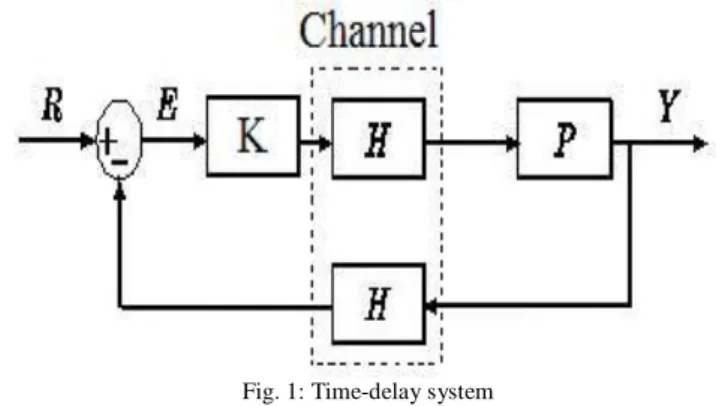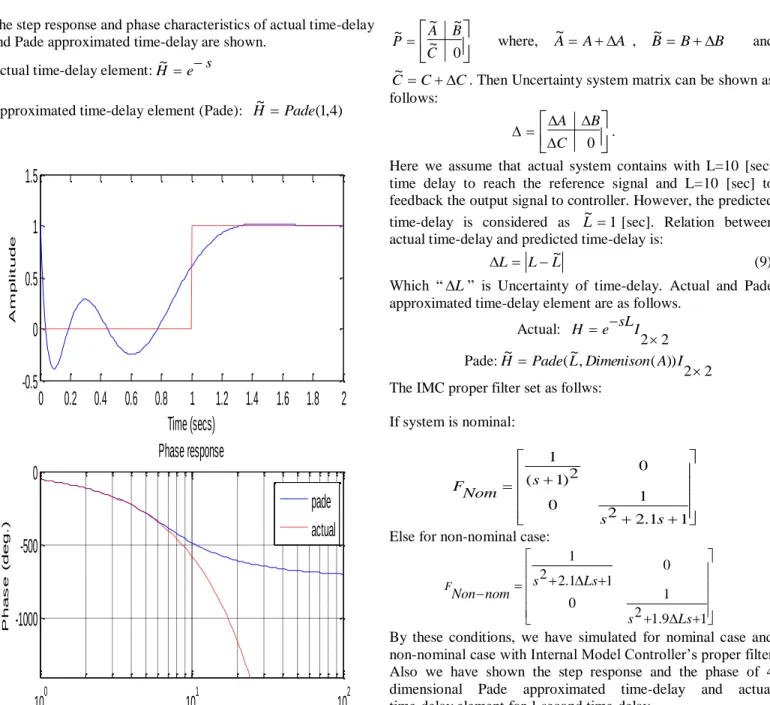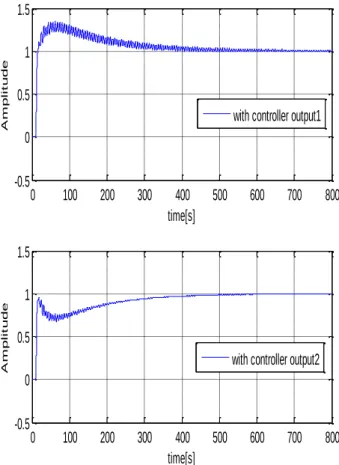Title
Evaluation of Linear-Quadratic-Integration and Internal Model
Control on Application to Wind Turbine Considering Round
Trip Delay in Feedback Control System
Author(s)
Asharif, Faramarz; Tamaki, Shiro; Nagado, Tsutomu; Nagata,
Tomokazu; Alsharif, Mohammad Reza
Citation
琉球大学工学部紀要(72):
---Issue Date
2011
URL
http://hdl.handle.net/20.500.12000/24375
Evaluation of Linear-Quadratic-Integration and Internal Model Control on Application to
Wind Turbine Considering Round Trip Delay in Feedback Control System
Faramarz Asharif
*, Shiro Tamaki
**, Tsutomu Nagado
**, Tomokazu Nagata
**and
Mohammad Reza Alsharif
***University of the Ryukyus Graduate School of Science and Engineering
**University of the Ryukyus Faculty of Engineering
faramarz_asharif@yahoo.com
Abstract
In this paper, we aim to analysis the system which contains time-delay elements including closed loop system and uncertainty. Time-delay will happen during the long distance communication. Therefore, when we have a control object in a long distance, the transmitted reference signal will be delayed certainly. For this reason even though we assume the control object system is a stable, but it will be an unstable system due to existence of time-delay elements. So, we consider the Internal Model Controller method which is one of the robust controllers. Internal Model Controller method is composed of optimum controller and uncertainty model of control object and time-delay elements. The optimum controller is designed by minimizing the coefficients of external disturbance of output signal by H2 norm in order to stabilize the closed loop system considering the uncertainty of control object and predicted time-delay. Also, in order to compare the performance of the Internal Model Controller, we have compared with Linear Quadratic Integration method. As results the performance of Internal Model Controller was much better than the Linear Quadratic Integration method.
Keywords: Internal Model Controller, Tele-Operation, H2 Norm, MIMO (Multi Input Multi Output) System.
1. Introduction
In this research, we propose control of the time-delay system by using IMC (Internal Model Controller) [1-5]. There were many schemes and suggestions to consider the designing controller for systems which includes time-delay elements. For example the classical way is PID controller [6-8] (Proportional, Integral Derivative). However, this scheme is not suitable for large time-delay. On the other hand, LQI (Linear Quadratic Integration) [9] method which is modern way and it warranties the stability even for a large time-delay. However, for MIMO (Multi Input Multi Output) system, it is very difficult to solve the Ricatti equation to design the optimum controller. Therefore, we consider IMC method to control the system including time-delay elements. Time-delay will happen during utilization of the long distance communication. The application of the long distance communication is an important issue in aerospace engineering. When we have a control object in the long distance, the transmitter’s signal will be delayed. Therefore the received signal at the control object will also be delayed. Moreover, the feedback signal to transmitter location will also be delayed. So, in this case, we have a round trip delay, one delay is to reach the control object and another delay is to receive the feedback signal for comparison with the reference signal. This comparison makes the error signal of the control system. This error must be decreased for a better performance. Moreover, control object will be unstable due to time-delay elements. Therefore, in this paper we consider the stability of control object and its uncertainty. Also, not only the uncertainty of control object, but also the uncertainty of time-delay elements which is estimated and approximated by using Pade approximation [10] has been considered. IMC method is minimizing the coefficient of external disturbance of output signal by H2 norm. Therefore, by this design problems of the system instability, uncertainty and external disturbance have
been overcomes. Then, it can be solved by one of the robust controller such as IMC method.
2. Back Ground of Research and Internal Model
Controller
As we express in introduction in this research we have a round trip time-delay system which means one delay element to reach the control object and another delay element to feedback the output signal in order to compare with reference signal. Figure 1 shows the block diagram of a round trip time-delay system with controller.
Fig. 1: Time-delay system
Here “Y”,”H”,”R”,”P” and “E” are the output signal of the system, time-delay element, reference signal, control object and error signal of the system, respectively. It is clear that the sensitivity (S) and transfer function (T) are:
) 2 (I PKH S (1) PKH PKH I T ( 2)1 (2)
Generally, in feedback control system, by inserting a controller such as “K” which is designed corresponding to control object, minimize the error signal. Therefore, in classical control usually PID controller and in modern control integrator operation and optimum gain such as LQI method are used. But, minimizing the error signal of the system is not enough. Also, we have to make the system stable if it is an unstable. For example, in the case of PID controller, if time-delay is large, system could not preserve the stability. But for Modern scheme LQI method we could make the system stable without error. However, for high dimension and MIMO system we couldn’t design the optimum controller because of complexity of solving the Ricatti equation. Therefore, in this research we propose the IMC method which is one of the robust controllers. Internal Model Controller is an optimum controller which minimizes the effect of disturbance to output signal and considers the uncertainty of control object. Also in this research we consider the existence of time-delay elements. Hence most of systems would be an unstable system due to time-delay elements. We suggest the IMC method to modify the stability of the system and compensate the output signal. The main reason that we suggest the IMC method is due to consideration of the uncertainty of control object and time-delay elements. The effects of disturbance to output signal are minimized and it can be correspondence to MIMO and high dimension systems. In order to modify the unstable system due to time-delay elements, we have designed the internal model controller. Figure 2 shows the IMC system which “D” is external disturbance to output signal, ”K” is Internal Model Controller, ”P”, ”H” and “ P~ ”, “ H~ ” are actual system, actual time-delay element and model system, approximated and predicted time-delay element, respectively. Follwing figure shows the structures of IMC.
Fig. 2: Structure of IMC with time-delay and disturbance
Here through figure 2 the block diagram of IMC method, we obtained relation between output and reference signal as follows. d PHMKH I PHMKr y ( ) (3) Where, Gis Uncertainty of plant and time-delay element:
H P H HPH
G ~~~
and M is the sensitivity function of IMC
isM (IGK)1.
Since, in the above equation (3) external disturbance multiplied by “IPHMKH” Which IMC method minimizes the effect of disturbance. As a result we consider the minimization of H2 norm of this coefficient. Equation (4), below, shows how to derive “K” which is Internal Model Controller:
2 minI PHMKH
K (4)
Theoretically, the optimum Controller K in equation (5) is calculated when:
1 ~ P
K (5) Where, “K” is the inverse system of control object’s model system. Also, if there is no uncertainty exists in system then equation (3) can be rewritten as follows:
d PHKH I
PHKr
y ( ) (6) As it is clear, the effect of time-delay elements is cancelled in closed-loop system and it exists only in input delay. However, generally, the uncertainty effects cannot be cancelled if actual system is unknown. Next Chapter, we discuss more about uncertainty.
3. Uncertainty of Control Object and Time-Delay
Element
In this case of IMC, we use the model of control object and the actual control object which is an unknown system. So, as it obtained through equation (4) when “K” is the inverse system of model, it is optimum case and minimizes the effects of external disturbances. However, if this model system does not completely match with the actual system, it will be feedback the error between the model and the actual system. So, the ideal case of this system is when the sensitivity function of IMC equal to unitary matrix, that is when G 0M I , system is called nominal which is an ideal case. Although in the case of internal model controller except the model system, it requires to realize the predicted time-delay element. Therefore, it has used the Pade approximation for “L~ ” which is an approximated time-delay i.e. time-delay elements that it can be indicate as”H~ ” has shown as follows:
n k k s k L k c n k k s k L k c k n L Pade L s e H 0 ~ 0 ~ ) 1 ( ) , ~ ( ~ ~ (7) Where, )! ( ! ! 2 ! )! 2 ( k n k n n k n k c for (k0.,1,2,...,n)
Here we consider this approximated time-delay element as a transfer matrix.
H D H C H B H A H ~ ~ ~ ~ ~ (8)The step response and phase characteristics of actual time-delay and Pade approximated time-delay are shown.
Actual time-delay element:H~ es
Approximated time-delay element (Pade): H~ Pade(1,4)
Fig. 3: Pade approximation and actual time-delay
4. Numerical Analysis
For evaluating the IMC method we have simulated wind turbine system. The process of simulation is first to simulate the step response of LQI method and then with IMC including nominal case and non-nominal case. The simulation condition shown as follows. Actual system: 0 0 0 1 0 0 0 0 0 0 1 0 0 0 0 0 1 0 1430 . 0 1530 . 0 1530 . 0 4650 . 0 3880 . 0 0500 . 3 0077 . 0 4750 . 0 4750 . 0 0318 . 0 1150 . 0 5980 . 0 0 0073 . 0 0415 . 0 0802 . 0 9968 . 0 0558 . 0 0 C B A P
Predicted Model system has additional uncertainty which has shown as follows:
0 ~ ~ ~ ~ C B A P where, A~AA , B~BB and C CC~ . Then Uncertainty system matrix can be shown as follows:
0 C B A .Here we assume that actual system contains with L=10 [sec] time delay to reach the reference signal and L=10 [sec] to feedback the output signal to controller. However, the predicted time-delay is considered as L~1[sec]. Relation between actual time-delay and predicted time-delay is:
L L L ~
(9) Which “ L ” is Uncertainty of time-delay. Actual and Pade approximated time-delay element are as follows.
Actual: 2 2 e sLI H Pade: 2 2 )) ( , ~ ( ~ Pade L Dimenison A I H
The IMC proper filter set as follws: If system is nominal: 1 1 . 2 2 1 0 0 2 ) 1 ( 1 s s s Nom F
Else for non-nominal case:
1 9 . 1 2 1 0 0 1 1 . 2 2 1 Ls s Ls s nom Non F
By these conditions, we have simulated for nominal case and non-nominal case with Internal Model Controller’s proper filter. Also we have shown the step response and the phase of 4 dimensional Pade approximated time-delay and actual time-delay element for 1 second time-delay.
Fig. 4: Step response of LQI
0
0.2 0.4
0.6 0.8
1
1.2 1.4
1.6 1.8
2
-0.5
0
0.5
1
1.5
Time (secs)
A m p l i t u d e10
010
110
2-1000
-500
0
Frequency (rad/s)
P h a s e ( d e g . )Phase response
pade
actual
0 100 200 300 400 500 600 700 800 -30 -25 -20 -15 -10 -5 0 5 Time[s] A m p li tu d e LQI Output1 LQI Output2Fig. 5: Step response with controller non-nominal case
From figure 4, it is clear that system with LQI its performance is very poor and the output does not converge to reference signal. Therefore, Internal Model Controller is suggested in order to realize a good performance and reduce the effects of time-delay in closed-loop. However, comparing the figure 6 and 7, non-nominal case has also very late settle time and big overshoots comparing to nominal case. This is because of the uncertainty system which exits in sensitivity function of IMC in the case of non-nominal.
5. Conclusion
In this research Internal Model Controller stabilize the closed loop system including round trip delay containing with much less error comparing to LQI method. However, for proposed controller it considered the uncertainty of control object and approximated time-delay element. Therefore, even though system is non-nominal, Internal Model Controller can be corresponded. For the system’s performance it can be adjusted with proper filter and filter itself automatically adjustable by ΔL which is uncertainty of time-delay. However the demerit point of IMC is that realization of controller is quite hard due to existence of Pade filter, especially when control object includes high order and in consequence the controller becomes high order. So, the reduction of controller’s dimension would be one of the important future works.
References
[1] R.C.Dorf, R. H .Bishop, 2002 “Modern d ControlSystem”,Prentice Hall [2] Witold Pedrycz, 2007 “Robust Control Design an Optimal control Approach”
Wiley
[3] G.F.Franklin, J.D.Powell, M.Workman, 1997,”Digital [4] Control Dynamic System” Addison –Wesley
[5] R. Oboe, K. Natori, K. Ohnishi, 2008, ”A Novel Structure of Time Delay Control System with Communication Disturbance Observe” IEEE [6] J.E. Normey-Rico and E.F. Camach, 2007, “Control of dead time processes”
springer
[7] Guillermo J., SilvaAniruddha Datta, S.R Bhattacharyya, 2004, “PID Controller for Time-Delay System” Birkhauser
[8] G. Chesi, A. Garulli, A. Tesi, A. Vicino, 2009, “Homogeneous Polynomial Forms for Robustness Analysis of Uncertain Systems.” Springer
Sigurd Skogestad, Ian Postlethwaite, 1996 “Multi Variabla [9] Feedback Control Analysis and Design” JOHN WIEY
[9] F .Asharif, S.Tamaki, T.Nagado, T,Nagata, M. Rashid, M. Asharif , 2009, “Feedback Control of Linear Quadratic Integration Including Time-Delay System” ITC-CSCC
[10] Dan Simon, 2006, “Optimal State Estimation Kalman, H infinity and Nonlinear approaches” WILEY
Fig. 6: Step response with controller nominal case
0 100 200 300 400 500 600 700 800 -15 -10 -5 0 5 time[s] A m p li t u d e
with controller output1
0 100 200 300 400 500 600 700 800 -5 0 5 10 15 time[s] A m p li t u d e
with controller output2
0 100 200 300 400 500 600 700 800 -0.5 0 0.5 1 1.5 time[s] A m p li t u d e
with controller output1
0 100 200 300 400 500 600 700 800 -0.5 0 0.5 1 1.5 time[s] A m p li t u d e


